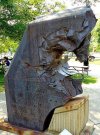I've heard of but haven't read Shattered Sword - I'll add it to the list. Fighters chewed up torpedo bombers on both sides. The Kates were effective until the USN got their shit together with regards to fighter direction, and got better fighters to go along with it. And Yamato and Musashi had no CAP by the time they were getting torpedoes tossed at them. Your point about the American torpedoes goes along with my overall argument - the US started the war with technology and tactics that did not stand up to a real war against a peer competitor.
In another example, for reasons of shiphandling and damage repair, the US prewar had decided to armor the main deck (ie, hangar deck) of their carriers, not the flight deck. The British had armored flight decks, and the British carriers that entered the Pacific War in 1944-45 were shrugging off kamikaze hits that were completely disabling US carriers.
The problem isn't willingness to war game, then or now. The Fleet Problems were for the most part creative and robust exercises that exposed real weakness in US doctrine and tactics - the vulnerability of anchorages to carrier air attack, for example. The participants had much more latitude than a CAG would have at Air Wing Fallon today. Then as now, it's for nothing if you're not willing to honestly assess and implement the lessons of those games.
In another example, for reasons of shiphandling and damage repair, the US prewar had decided to armor the main deck (ie, hangar deck) of their carriers, not the flight deck. The British had armored flight decks, and the British carriers that entered the Pacific War in 1944-45 were shrugging off kamikaze hits that were completely disabling US carriers.
The problem isn't willingness to war game, then or now. The Fleet Problems were for the most part creative and robust exercises that exposed real weakness in US doctrine and tactics - the vulnerability of anchorages to carrier air attack, for example. The participants had much more latitude than a CAG would have at Air Wing Fallon today. Then as now, it's for nothing if you're not willing to honestly assess and implement the lessons of those games.


